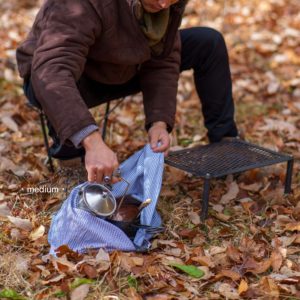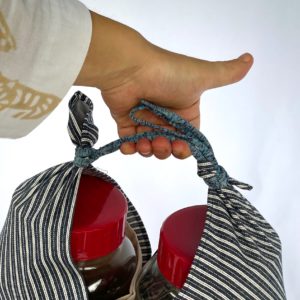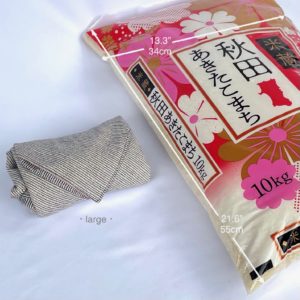「コットンあずま袋 Origami Bag」について
ヒッコリー コットン 100% hickory cotton
明治時代に西洋文化が輸入された際に
日本でもバックが開発されました。
そして風呂敷3枚を使って作られたバックがあずま袋です。
レジ袋有料化に伴いあずま袋が再認識されています。
あずま袋は風呂敷3枚から出来ていますので
畳むと平らになり、使う時は立体になります。
これは西洋の立体裁断にはない和裁の特徴である直線縫いならではの現象です。
生地を無駄にしないという考え方です。
解いて反物に戻し洗うことを想定した着物と同じ考え方です。
まるで折り紙のように平面から立体に展開します。
生地にはヒッコリーを使用しています。
ヒッコリーはアメリカで誕生したワークウェアの為の生地で、
汚れが目立ちにくく丈夫なのが特徴のデニム生地です。
ショッピングバックとしてはもちろん
Sサイズはランチボックスとして
Mサイズは鞄として
Lサイズはアウトドア用品などのツールボックスとして
お客様の用途に合わせてご利用頂ける
折り畳めば小さくなって持ち運びしやすい
サブバックとしてご利用いただいております。
When Western culture was imported during the Meiji Era
Western culture was imported to Japan during the Meiji era (1868-1912), and bags were developed in Japan.
The azuma-bukuro is a bag made of three furoshiki wrapping cloths.
With the introduction of a charge for plastic bags, the azuma-bukuro has been rediscovered.
Azuma bags are made from three sheets of furoshiki cloth.
When folded, it lies flat, but when used, it becomes three-dimensional.
This is a phenomenon unique to straight stitching, a characteristic of Japanese sewing that is not found in Western three-dimensional cutting.
The idea is not to waste fabric.
This is the same concept as that of a kimono, which is supposed to be taken apart and returned to the fabric for washing.
Like origami, it develops from a flat surface into a three-dimensional object.
Hickory is used for the fabric.
Hickory is a fabric for workwear that was born in the United States.
It is a denim fabric characterized by its durability and resistance to stains.
It can be used as a shopping bag as well as a lunch box.
Size S as a lunch box
Size M as a bag
The L size can be used as a tool box for outdoor equipment, etc.
It can be used according to the customer's purpose.
Fold it up to make it small and easy to carry.
It can be used as a sub-bag.
3サイズ
















































たたみ方
How to fold an origami bag
ORIGAMI BAG
オプション
お好みで追加オプションもございます。
